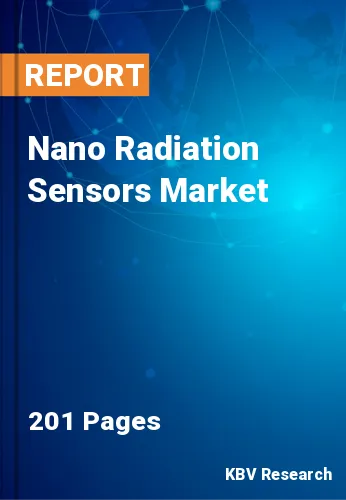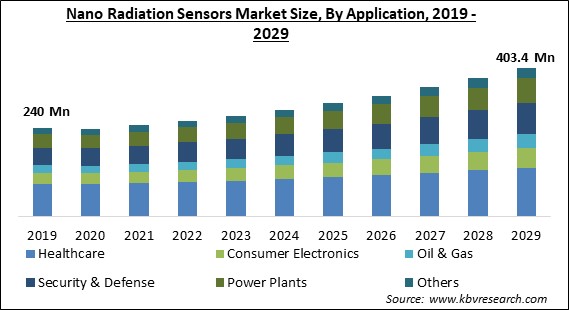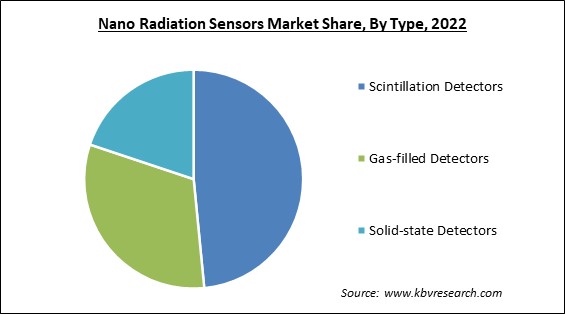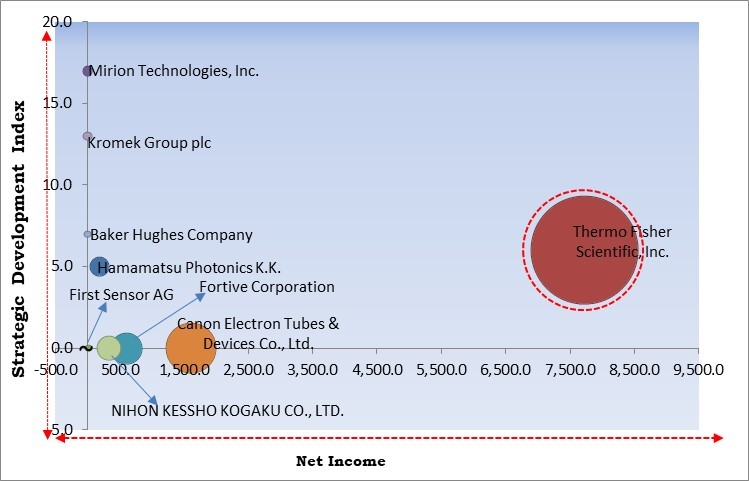
The Global Nano Radiation Sensors Market size is expected to reach $403.4 Million by 2029, rising at a market growth of 6.7% CAGR during the forecast period.
Alpha, beta, gamma, and neutron radiation are just a few of the different types of radiation that nano radiation sensors can detect and analyze. These sensors can be utilized in various settings, such as medical imaging, nuclear power plants, and for monitoring the environment. They are made to be extremely sensitive and accurate.

A small chip or film constructed from a radiation-detecting substance, like silicon, gallium arsenide, or diamond, often makes up nano radiation sensors. The sensor detects and interprets the signal created due to the radiation's interaction with the substance. The dimensions and form of the sensor can be controlled with incredibly fine detail because of the use of nanotechnology, which can improve the sensor's sensitivity and accuracy.
Nano radiation sensors detect radiation using cutting-edge components and methods like quantum dots, graphene, and carbon nanotubes. They are quite good at picking up ionizing radiation, which is bad for both people and the environment. They have the ability to detect other radiation types as well, including electromagnetic radiation, which is frequently utilized in medical imaging.
When radionuclides contaminate the environment, problems with fixing radiation sources arise. Their detection presents challenges due to low concentration. Biological processes are fundamentally altered by prolonged exposure to radiation sources, even at low concentrations.
When radiation sources' concentrations are low, it may be possible to investigate them using contemporary technical registration facilities. For instance, the optical range may record very faint luminescence, practically single photons. With the aid of artificial or natural adsorbents, radionuclide concentration in a liquid medium can be raised.
The increasing demand for medical supplies and equipment during the pandemic has been one of the main factors affecting the market for nano radiation sensors. In addition, the need for radiation sensors for use in medical settings has dramatically increased as healthcare facilities throughout the world rushed to address the spike in COVID-19 cases. Radiation sensors, for instance, have been utilized to track radiation exposure in medical facilities where COVID-19 patients are being treated, as well as in testing facilities for COVID-19. As a result, the need for micro radiation sensors in the medical industry has increased and aided the market in recovering from the losses.
Numerous manufacturers in the market for nano radiation sensors and research institutions are concentrating on developing technologically cutting-edge nuclear radiation sensor devices for use at airports, border crossings, and ports to support a nation's nuclear surveillance capability. Furthermore, solid-state and scintillation detectors are employed in these applications. Thus, the wide usage of nano radiation sensors to ensure the safety and security of a nation, joined with their utilization in the medical industry, is expected to surge their demands and aid the market growth in the projected period.
Nano-carbon demonstrates exceptional strength and unusual electrical characteristics. In nanotechnology, high aspect ratio resonators and sensors are also used using carbon nanotubes. Specific atomic lattice configurations of carbon nanotubes are used to provide the appropriate electrical conductivity in nanoscale sensor applications. Furthermore, because this technology can be used to create gas or liquid chemical sensors with incredibly low power requirements, versatility, and ultra-miniature in size, as well as an advantage of low cost, carbon nanotube-based nano sensors are acceptable and advantageous for chemical and nano radiation detection. Over the following few years, this is anticipated to increase demand for nano radiation sensors further, boosting the market expansion.
One major drawback of chemical nanosensor handling is that its detecting mechanism cannot be used in physiological fluids, particularly when there is a significant concentration of salts. Because an electronic detection system depends on its existence and difference of charge, buffers made of various salts will interfere with the charge interaction and reduce the sensitivity of the nanosensor. For instance, nanowire FETs require a salt concentration of less than one mM. One strategy for better nanosensors' performance is to lower the salt concentration by purifying and pretreating the sample of interest. Thus, such complications are expected to decrease their utilization and hamper the market growth.
Based on type, the nano radiation sensors market is characterized into scintillation detectors, solid-state detectors, and gas-filled detectors. The scintillation detectors segment dominated the nano radiation sensors market with maximum revenue share in 2022. This is because measurements could be made using photographic film and scintillates are among the earliest types of radiation detectors. It is possible to gather images or assess intensity. The brightness and frequency of flashes in the scintillator were also measured using the human eye.

On the basis of application, the nano radiation sensors market is classified into healthcare, consumer electronics, security & defense, oil & gas, power plants, and others. The security & defense segment garnered a substantial revenue share in the nano radiation sensors market in 2022. This is due to the fact that finding nuclear and radioactive items is essential to ensure safety and security. As a result, radiation monitors are a component of the defense system used by military personnel. The military uses these tools to prevent terrorist acts, keep illegal radioactive materials under control, and seize them. In addition, these are used for site and source surveys following nuclear and radiation incidents.
| Report Attribute | Details |
|---|---|
| Market size value in 2022 | USD 259.3 Million |
| Market size forecast in 2029 | USD 403.4 Million |
| Base Year | 2022 |
| Historical Period | 2019 to 2021 |
| Forecast Period | 2023 to 2029 |
| Revenue Growth Rate | CAGR of 6.7% from 2023 to 2029 |
| Number of Pages | 201 |
| Number of Table | 293 |
| Report coverage | Market Trends, Revenue Estimation and Forecast, Segmentation Analysis, Regional and Country Breakdown, Competitive Landscape, Companies Strategic Developments, Company Profiling |
| Segments covered | Type, Application, Region |
| Country scope | US, Canada, Mexico, Germany, UK, France, Russia, Spain, Italy, China, Japan, India, South Korea, Singapore, Malaysia, Brazil, Argentina, UAE, Saudi Arabia, South Africa, Nigeria |
| Growth Drivers |
|
| Restraints |
|
Region wise, the nano radiation sensors market is analyzed across North America, Europe, Asia Pacific, and LAMEA. The North America region witnessed the largest revenue share in the nano radiation sensors market in 2022. This is because many top nanosensors companies are based in North America, which has a long-standing technology sector. Additionally, the region has a strong demand for cutting-edge technologies and a favorable regulatory environment, which have encouraged significant investments in the industry's R&D of nanosensors, which will also boost innovation for nano radiation sensor devices.
Free Valuable Insights: Global Nano Radiation Sensors Market size to reach USD 403.4 Million by 2029

The major strategies followed by the market participants are Product Launches. Based on the Analysis presented in the Cardinal matrix; Thermo Fisher Scientific, Inc. is the forerunner in the Nano Radiation Sensors Market. Companies such as Mirion Technologies, Inc., Kromek Group plc, and Baker Hughes Company are some of the key innovators in Nano Radiation Sensors Market.
The market research report covers the analysis of key stake holders of the market. Key companies profiled in the report include Mirion Technologies, Inc., Fortive Corporation (Fluke Corporation), Hamamatsu Photonics K.K., Thermo Fisher Scientific, Inc., Baker Hughes Company, Canon Electron Tubes & Devices Co., Ltd. (Canon, Inc.), Kromek Group plc, PCE Instruments, First Sensor AG (TE Connectivity Ltd.), and NIHON KESSHO KOGAKU CO., LTD. (MITSUI MINING & SMELTING CO., LTD.).
By Application
By Type
By Geography
The Market size is projected to reach USD 403.4 Million by 2029.
The wide-ranging application of nano radiation sensors are driving the Market in coming years, however, Drawbacks associated with nano radiation sensors restraints the growth of the Market.
Mirion Technologies, Inc., Fortive Corporation (Fluke Corporation), Hamamatsu Photonics K.K., Thermo Fisher Scientific, Inc., Baker Hughes Company, Canon Electron Tubes & Devices Co., Ltd. (Canon, Inc.), Kromek Group plc, PCE Instruments, First Sensor AG (TE Connectivity Ltd.), and NIHON KESSHO KOGAKU CO., LTD. (MITSUI MINING & SMELTING CO., LTD.).
The Healthcare segment is leading the Market by Application in 2022 thereby, achieving a market value of $132.3 Million by 2029.
The North America market dominated the Market by Region in 2022, and would continue to be a dominant market till 2029; thereby, achieving a market value of $149.1 Million by 2029.
Our team of dedicated experts can provide you with attractive expansion opportunities for your business.
